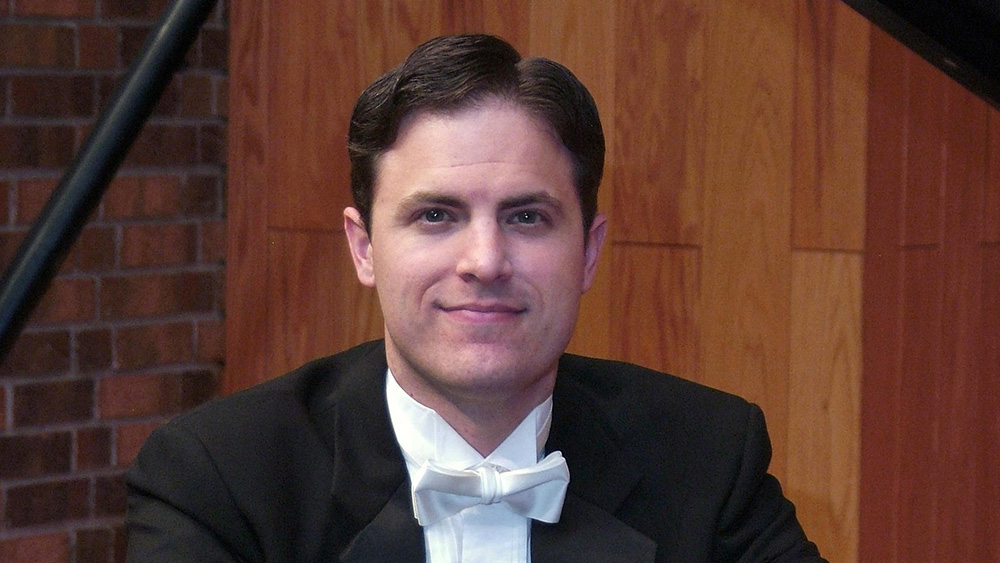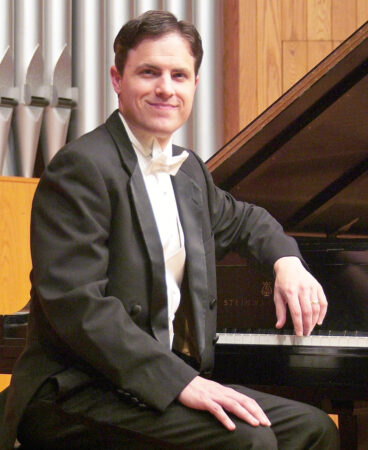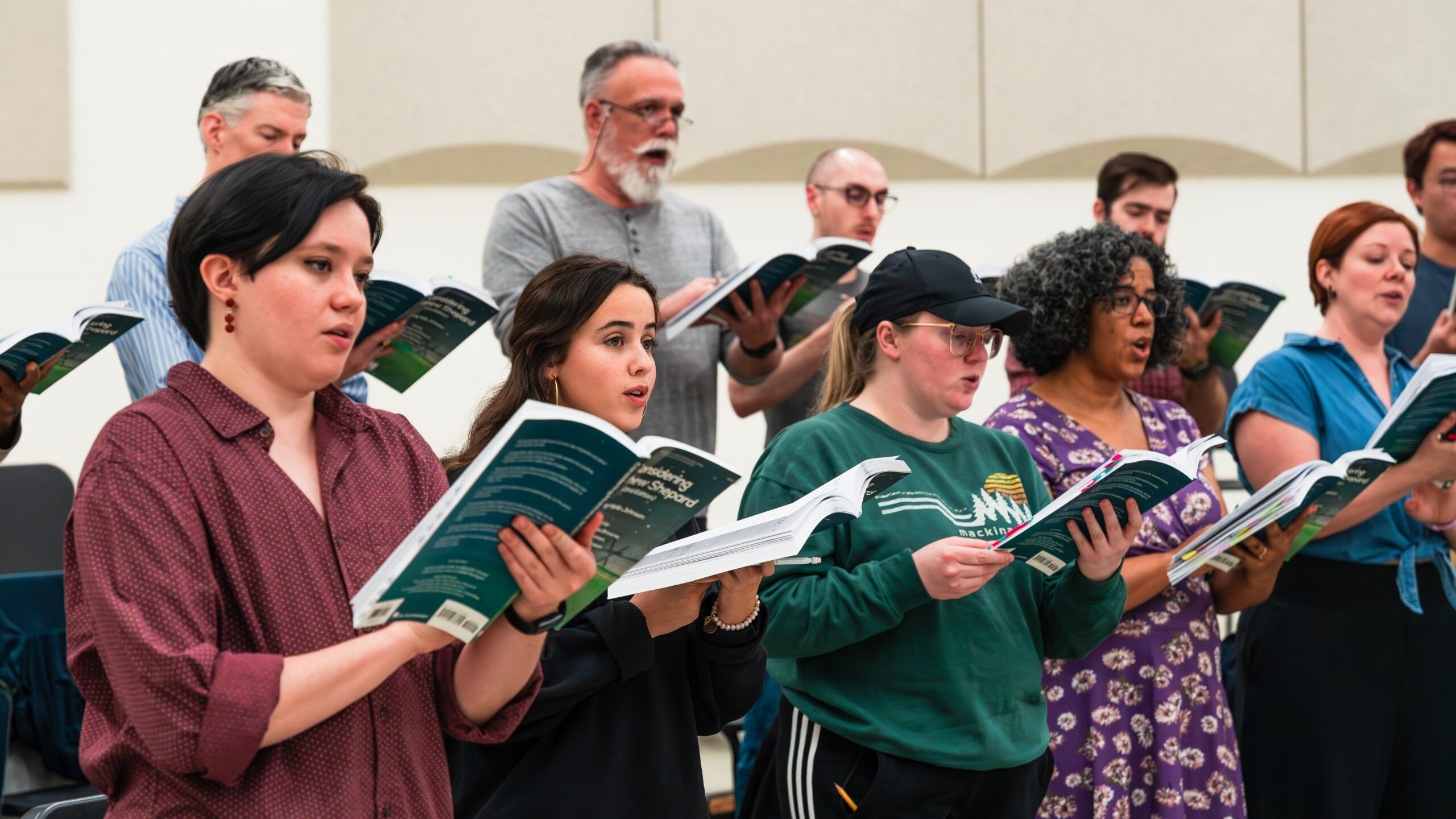Guest recital by pianist Ryan Fogg

Join us in Price Music Center for a guest piano recital by pianist Ryan Fogg, a Professor of Music and the Director of Keyboard Studies at Carson-Newman University. Fogg will perform selections by Frédéric Chopin. This recital is free and open to the public.
Ryan Fogg, Pianist
A Sampling of the Piano Music of Frédéric Chopin (1810-1849)
March 4, 5:00 p.m.
Price Music Center room 110
Free, no advance registration required

Recital Program
| Prelude in F-sharp major, Op. 28, No. 13 | Frédéric Chopin (1810-1849) |
| Etude in B minor, Op. 25, No. 10 | |
| Nocturne in E major, Op. 62, No. 2 | |
| Polonaise in C-sharp minor, Op. 26, No. 1 | |
| Mazurka in C-sharp minor, Op. 50, No. 3 | |
| Waltz in A-flat major, Op. 34, No. 1 | |
| – | |
| Ballade No. 4 in F minor, Op. 52 | |
| – | |
| Sonata No. 3 in B minor, Op. 58 | |
| Allegro maestoso | |
| Scherzo: Molto vivace | |
| Largo | |
| Finale: Presto, non tanto |
About Ryan Fogg
The playing of pianist Ryan Fogg has been described as “brilliant, with a high level of polish, impressive technical command, musical understanding and sensitivity.” As an artist, he strives to convey the musical line with clarity while capturing the coloristic sonority of the instrument. Audiences agree that his balanced and varied programming is quite effective in combining the standard masterpieces of the repertoire with less frequently heard but equally deserving works.
He has presented solo recitals in California, Michigan, Iowa, Nebraska, Missouri, Kansas, Texas, Arkansas, Mississippi, Georgia, Alabama, North Carolina, South Carolina, Kentucky, Virginia, Ohio, and Tennessee. In addition, he is an avid chamber musician, collaborative pianist, and concerto soloist. His orchestral debut occurred while performing Stravinsky’s Concerto for Piano and Winds with the Knoxville Wind Symphony at the historic Tennessee Theatre. In 2011, he released a CD recording through Albany Records entitled “The Fogg Project,” featuring new works by American composers. A subsequent review of the recording by Fanfare Magazine described Fogg as “an excellent pianist, drawing an impressive range of sounds out of his instrument.”
Originally from Houston, Texas, Dr. Fogg holds degrees in piano performance from The University of Texas at Austin, The University of Houston, and East Texas Baptist University. His major teachers include Gregory Allen, Danielle Martin, Robert Brownlee, and Randall Sulton. He pursued additional studies at the Aspen Music Festival with Gabriel Chodos and the Adamant Music School with Deirdre O’Donohue, and he has performed in masterclasses for pianists Horacio Gutierrez, Angela Cheng, Ann Saslov, Baruch Meir, and Menahem Pressler.
He currently holds the position of Professor of Music and Director of Keyboard Studies at Carson-Newman University, where he teaches a wide range of courses, including applied piano, piano literature, piano ensemble, ear training, and form & analysis. A dedicated teacher, he has been recognized by Carson-Newman with the Teaching Excellence and Leadership Award and twice with the Faculty Creativity Award. In 2009-2010, he was named Teacher of the Year by the Knoxville Music Teachers Association.
He previously served on the Executive Board of the Tennessee Music Teachers Association as the Senior Piano Competitions Chair for nine years, and he holds Permanent Professional Certification through the Music Teachers National Association. He has presented numerous master classes, workshops, and lecture-recitals at various institutions, as well as local, state, and regional conferences. He is in high demand as an adjudicator for local and state festivals and competitions, and he is well-published, having written articles for Clavier Companion, American Music Teacher, and Piano Pedagogy Forum on various topics relevant to piano students and teachers alike. He has previously served on the faculties of Northwest Missouri State University and Blue Lake Fine Arts Camp in Michigan.
Program Notes
Pianist and composer Frédéric Chopin was born in Warsaw, Poland and received most of his musical training from the Warsaw Conservatory. When he was 19, he began to concertize across Europe, but he settled in Paris in 1831 and devoted himself to composing, teaching, and playing locally. Unlike many of his contemporaries, he composed almost exclusively for piano, writing over 200 solo pieces for the instrument. Rather than attempting to achieve orchestral sounds with the piano, Chopin fully explored the inherent acoustical properties of the piano itself. His harmonic approach was quite original for his time, including the extensive use of chromaticism, frequent dissonance, and unusual harmonic progressions. His long melodic lines and ornamental decoration show an association with the bel canto style, particularly with the operas of Bellini, whose works Chopin adored. Author Stewart Gordon summarized Chopin’s style by saying that he “combined elements of a restraint born of Classicism with a personal sense of freedom that we associate with the Romantic movement.” His piano music can be categorized into three general types of pieces: character pieces (both large and small), stylized dance pieces, and traditional forms (such as the sonatas). This program will explore each of these types of works to provide a sampling of the composer’s unique contribution to the piano literature.
Chopin’s preludes are modeled after Bach’s Well-Tempered Clavier in that all 24 keys are used. Also, most of the preludes are dominated thematically by a single motive; this thematic material is often either based on rapid figuration or is more lyrical in nature. The Prelude in F-sharp major is of the lyrical type and also explores colorful sonorities.
Etudes generally concentrate on one problem of pianistic execution throughout, but the value of Chopin’s etudes does not lie in their technical challenges alone; they also contain a high degree of expressive qualities, so much so that they are often called “virtuoso character pieces.” They are mostly in ABA form (sometimes with coda), with the middle section sometimes modulating into distant keys but maintaining the same thematic material. The Etude in B minor is known as the “octave” etude, a description that is immediately apparent upon hearing the opening of the piece.
Chopin’s concept of the nocturne is similar to that previously exhibited by Irish composer John Field, but his approach is more artistic. These pieces typically feature a simple lyrical melody, often ornamented; stereotypical accompaniment patterns; and a ternary structure, with a contrasting middle section. The composer’s creativity is particularly evident in the Nocturne in E major, where each recurrence of the main theme is slightly different than before, either through melodic ornamentation or an unexpected color change.
The polonaise originated as a ceremonial court dance, and many composers before Chopin wrote polonaises for piano, including J. S. Bach, W. F. Bach, Mozart, Beethoven, and Schubert. General characteristics of Chopin’s polonaises include the use of triple meter, a large ternary form, the prominence of the typical polonaise rhythm (repeated notes combining sixteenth and eighth notes in a military-like motivic pattern), and virtuosic writing. One unique feature in the Polonaise in C-sharp minor is its key relationships: the “A” section is in the expected tonic key of C-sharp minor, but the contrasting, lyrical “B” section is in the enharmonic key of D-flat major.
The mazurka originated as a folk dance and was named for the Mazur people of Central Poland; thus, it had very personal connotations for Chopin. In general, Chopin’s mazurkas are smaller, more intimate pieces, and they lack the virtuosity that is included in many of his other works. Here the composer maintains the essential features of the dance (such as irregular accentuations with a heightened sense of rubato, modal inflections, and a drone bass), but he also integrates other musical procedures (such as counterpoint and chromaticism, particularly in the Mazurka in C-sharp minor). The specific formal scheme will vary from one mazurka to another, but usually there are three or four alternating sections that contrast in key, thematic material, and character.
In piano music, the waltz had previously appeared either as a short, modest piece similar to the German ländler (as in those of Schubert) or as an elegant dance cultivated in the refined circles of the aristocracy. While many of Chopin’s early waltzes represent the shorter, simpler type, most of his efforts combine the more elegant waltz with a certain degree of brilliance. The specific form of each Chopin waltz will vary, but all of them display a sectional form to some extent, with short, contrasting sections appearing in between occurrences of the waltz proper. Some waltzes include a fanfare-like introduction and a brilliant coda, while others are noticeably more melancholy in their character. The Waltz in A-flat major is of the former type, carrying the label “Grand Valse Brillante.”
Chopin successfully established the genre of the ballade as a viable alternative to the more extended sonata and the less imposing character piece. While many scholars have attempted to relate these pieces to their literary counterparts, any direct correlation to a specific work is highly doubtful. With the four ballades, the composer effectively combined the dramatic with the poetic; each piece maintains a narrative quality while evoking a vast range of emotions and ultimately ending in tragedy. The F minor Ballade begins with a serene introduction, after which the opening theme emerges and establishes the tonic key. As the work unfolds, the repetitive nature of the thematic material yields itself to more chromatic and contrapuntal treatment. The transitions from one section to another are virtually seamless as the drama continues to build and eventually concludes with a tumultuous and fiery coda. The F minor Ballade is widely considered one of the composer’s finest works and one of the masterpieces of the piano literature.
Chopin composed the B minor Sonata in 1844, and it still stands today as one of the composer’s masterpieces. Structurally, this work is mostly traditional: the form of each movement is closely related to its eighteenth-century counterparts. The ingenuity of the sonata lies rather in its masterful juxtaposition of pianistic virtuosity and intensity with a sublime and profound expression. In the first movement, the opening thematic material is somewhat introductory in its character; this is reinforced by the fact that it does not appear again in the recapitulation. More prominent here is the second theme, which closely resembles a nocturne and later signals the arrival of the recapitulation. The seemingly disparate components of this movement require great flexibility of tempo, but such freedom must be exercised carefully so that the unity of the movement as a whole is still preserved. This movement, along with the finale, concludes in the parallel key of B major. The scherzo features continuous right-hand figuration in its opening section (the key of which is E-flat major), followed by a more nostalgic trio and an exact return of the opening section. The slow movement is also in ternary form. The primary section is very melodic in its presentation, whereas the middle section has a much greater harmonic quality. In fact, some of the more inspiring moments of the entire sonata come from the exploration of sonorities that are evident in this section. The primary section returns near the end with slight variations. The finale features a virtuosic display of ever-increasing tension as one section leads seamlessly into another in the familiar sonata-rondo form. Upon each return of the “A” section, the rhythmic values in the left-hand accompanying figure increase: first in triplets, then in quadruplets, finally in sextuplets. The endurance of the pianist is ultimately tested as the climactic coda approaches, thereby contributing to the already exhilarating nature of the ending.
Few, if any, of Chopin’s works have fallen out of the pianist’s standard repertoire. His unique contribution to the piano literature is inextricably tied to his experimentation with the sonorous possibilities of the instrument itself and his seemingly perfect blend of expressive cantabile with a virtuosity that is full of emotional intensity and technical brilliance.


